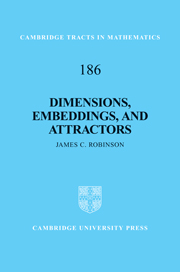Introduction
Published online by Cambridge University Press: 10 January 2011
Summary
Part I of this book treats four different definitions of dimension, and investigates what being ‘finite dimensional’ implies in terms of embeddings into Euclidean spaces for each of these definitions.
Whitney (1936) showed that any abstract n-dimensional Cr manifold is Cr-homeomorphic to an analytic submanifold in ℝ2n+1. This book treats embeddings for much more general sets that need not have such a smooth structure; one might say ‘fractals’, but we will not be concerned with the fractal nature of these sets (whatever one takes that to mean).
We will consider four major definitions of dimension:
(i) The (Lebesgue) covering dimension dim(X), based on the maximum number of simultaneously intersecting sets in refinements of open covers of X (Chapter 1). This definition is topologically invariant, and is primarily used in the classical and abstract ‘Dimension Theory’, elegantly developed in Hurewicz & Wallman's 1941 text, and subsequently by Engelking (1978), who updates and extends their treatment.
(ii) The Hausdorff dimension dH(X), the value of d where the ‘d-dimensional Hausdorff measure’ of X switches from ∞ to zero (Chapter 2). Hausdorff measures (and hence the Hausdorff dimension) play a large role in geometric measure theory (Federer, 1969), and in the theory of dynamical systems (see Pesin (1997)); the standard reference is Falconer's 1985 tract, and subsequent volumes (Falconer, 1990, 1997).
[…]
Information
- Type
- Chapter
- Information
- Dimensions, Embeddings, and Attractors , pp. 1 - 4Publisher: Cambridge University PressPrint publication year: 2010
